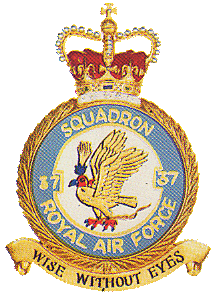| Description of the Squadron's Badge | A hawk hooded, belled and fessed, wings elevated and addorsed |  |
||||||||||||||||||||||||||
| Squadron's Motto: | Wise without eyes | |||||||||||||||||||||||||||
| Formation date: | 15/4/16 RFC at Orfordness, Suffolk | |||||||||||||||||||||||||||
| Brief History: | ||||||||||||||||||||||||||||
| Disbanded 1/7/19 when renumbered as No.39. Reformed 26/4/37 (Bomber), Disbanded 3/46. Reformed 4/46 when No.214 renumbered. disbanded 4/47, reformed in 9/47 (maritime recon). | ||||||||||||||||||||||||||||
No. 37 Squadron, RFC, was formed as an experimental squadron at Orfordness, Suffolk, on 15th April 1916, but ceased to exist a month later when the nucleus flight of the squadron was absorbed by the experimental station at Orfordness. In September 1916, it re-formed as a Home Defence squadron with its headquarters at Woodham Mortimer, in Essex. Flights operated from landing grounds at Rochford, Stow Maries and Goldhanger and constituted an eastern line of defence against raiding aeroplanes and airships for London. On the night of 16/17th June 1917, Lieutenant LP Watkins, a Canadian Army officer attached to No. 37 Squadron, was responsible for the destruction of the Zeppelin L48 over Suffolk; he was flying a BE12. After the Armistice No. 37, by then flying Sopwith Camels, was concentrated at Stow Maries and in March 1919, moved to Biggin Hill. In July 1919, it was re-numbered 39 Squadron. In April 1937, the squadron was re-formed as No. 37 (Bomber) Squadron from a nucleus provided by No.214 Squadron. It was equipped with Handley Page Harrows at first, but by the outbreak of the Second World War was flying Vickers Wellingtons. Seven hours after the outbreak of war, six of the squadron's Wellingtons took off to seek and attack German warships in the vicinity of Heligoland. Because of very bad weather conditions and the fact that darkness was falling by the time they reached the search area, they failed to locate any warships and returned to base with their bomb loads intact. A second operation of this kind, on 15th December, was also uneventful. The next, on 18th December, was disastrous - so disastrous, in fact, that Wellingtons were subsequently barred from approaching the shores of Germany by day. On this occasion a force of 22 Wellingtons, six from No. 37 and the remainder from Nos. 9 and 149 Squadrons, were pounced upon by Bf109's and 110's, which made beam attacks; to these tactics the Wellingtons had no reply owing to their limited fields of fire. In this operation No. 37 lost five of its six aircraft. A direct outcome of this air battle was the decision to fit Wellingtons with armour plate and self-sealing fuel tanks. In November 1940, by which time it had flown many more operations in Northern Europe - the great majority of them night-bombing operations - No. 37 moved to the Middle East to support allied operations in that region for the remainder of the war. On 2 October 1945 the Squadron moved to Palestine but returned to Egypt in December where it was disbanded on 31 March 1946. On 15 April 1946, No. 214 Squadron at Fayid was renumbered No. 37 which flew Lancasters until it was disbanded again on 1 April 1947. It reformed again in Palestine on 14 September 1947 flying Lancasters in the maritime reconnaissance role until May 1948 when it moved to Malta. In August 1953 No. 37 converted to Shackletons and in August 1957 it moved to Aden where it flew patrols until it disbanded on 7 September 1967.
|
||||||||||||||||||||||||||||
|
||||||||||||||||||||||||||||
|
Squadron Colours
|
|
|

Terms & Conditions
Subscribe
Report
My comments